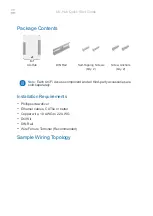
4
Anderson Greenwood
SerieS 9300 Pilot oPerated Safety relief ValVeS
InstallatIon and MaIntenance InstructIons
2.3 Main valve dual chamber diaphragm
disassembly (refer to figure 2)
1. remove the pilot and tubing from
the auxiliary diaphragm case.
note:
match mark orientation of tubing and
case assembly with the body. this will assist
in reassembly.
2. Unscrew the upper auxiliary case bolts
(700) and nuts (730), and remove the upper
auxiliary diaphragm case (210B).
3. install a 6” to 8” long braided wire through
the hole at the top of the lift rod (250) to retain
the lift rod (250). (See figure 3, detail C)
4. lift the auxiliary (160B, 170B, 290) and main
diaphragm (150, 160a, 170a) assemblies
to the full open position using the auxiliary
vacuum plate (160B). the open dome port
can be temporarily capped to hold the main
diaphragm assembly open.
5. remove nuts (530 and 520B) and Ptfe
o-ring (670). (See figure 3, detail a).
6. the lift rod (250) is attached to the auxiliary
plate bushing (240) with threads. Unscrew
the lift rod (250) from the bushing (240) by
turning the rod (250) clockwise until it drops
down into the main valve shaft bore (320).
7. remove the main diaphragm case bolts
(700, 710). remove the studs (810) from
the body (100). remove the lower auxiliary
diaphragm case (280B) and the upper main
diaphragm case (220) as a unit, which is
assembled to the diaphragm case adapter
(230). allow the lift rod (250) to slip from
the center hole and lift the lower auxiliary
diaphragm case (280B), upper main
diaphragm case (220), and adapter (230)
upwards as one unit.
cAution
Be careful not to bend the lift rod (250) during
case assembly removal.
8. on valve sizes 2” through 4”, remove
the diaphragm assembly (150, 160a, 170a),
lower case (280), shaft (320) and seat plate
assembly (910, 920) from the main valve
body (100).
9. on valve sizes 6” and larger, remove seat
plate assembly (910, 920) from shaft (320)
prior to removing diaphragm assembly
(150, 160a, 170a), lower case (280) and
shaft (320). to remove, spin diaphragm
plates (150, 160a, 170a) assembly
counterclockwise while holding seat plate
(910, 920) assembly stationary until shaft
(320) is free of seat hub (420). the seat plate
(910, 920) assembly should then rest on
nozzle (460).
10. on valve sizes 6” and larger, remove
diaphragm assembly (150, 160a, 170a) and
shaft (320) from lower case (280a). then
remove lower (280a) case from the body (100).
11. on valve sizes 6” and larger, lift seat plate
(910, 920) assembly from the body (100).
cAution
When removing seat plate assembly (910, 920),
be careful not to damage the nozzle (460).
12. Unscrew counterclockwise the seat
plate (910, 920) assembly from the main
shaft (320). this is normally a hand
operation, however, a
9
/
16
” (14.3 mm)
wrenching flat is provided on the seat
hub (420). the connecting thread will
run free, then tighten, and run free again
as it disengages from a locking helicoil
(330) in the vertical shaft (320). this will
allow the seat plate assembly (910, 920),
diaphragm (150, 160a, 170a) assembly and
lower case (280a) to be separated.
13. Holding the shaft (320) stationary,
remove the jam nut (520a) from the
diaphragm (150, 160a, 170a) assembly.
remove the diaphragms (170a, 175a, 950,
960), washers (580, 590, 600), gaskets
(620a), plates (150a, 160a), and lower
case (280a) (as a unit) from the shaft (320).
(See figure 3, detail C).
With the main valve disassembled, you are now
ready to disassemble, inspect, and replace soft
goods starting with the seat plate (910, 920)
assembly.





































